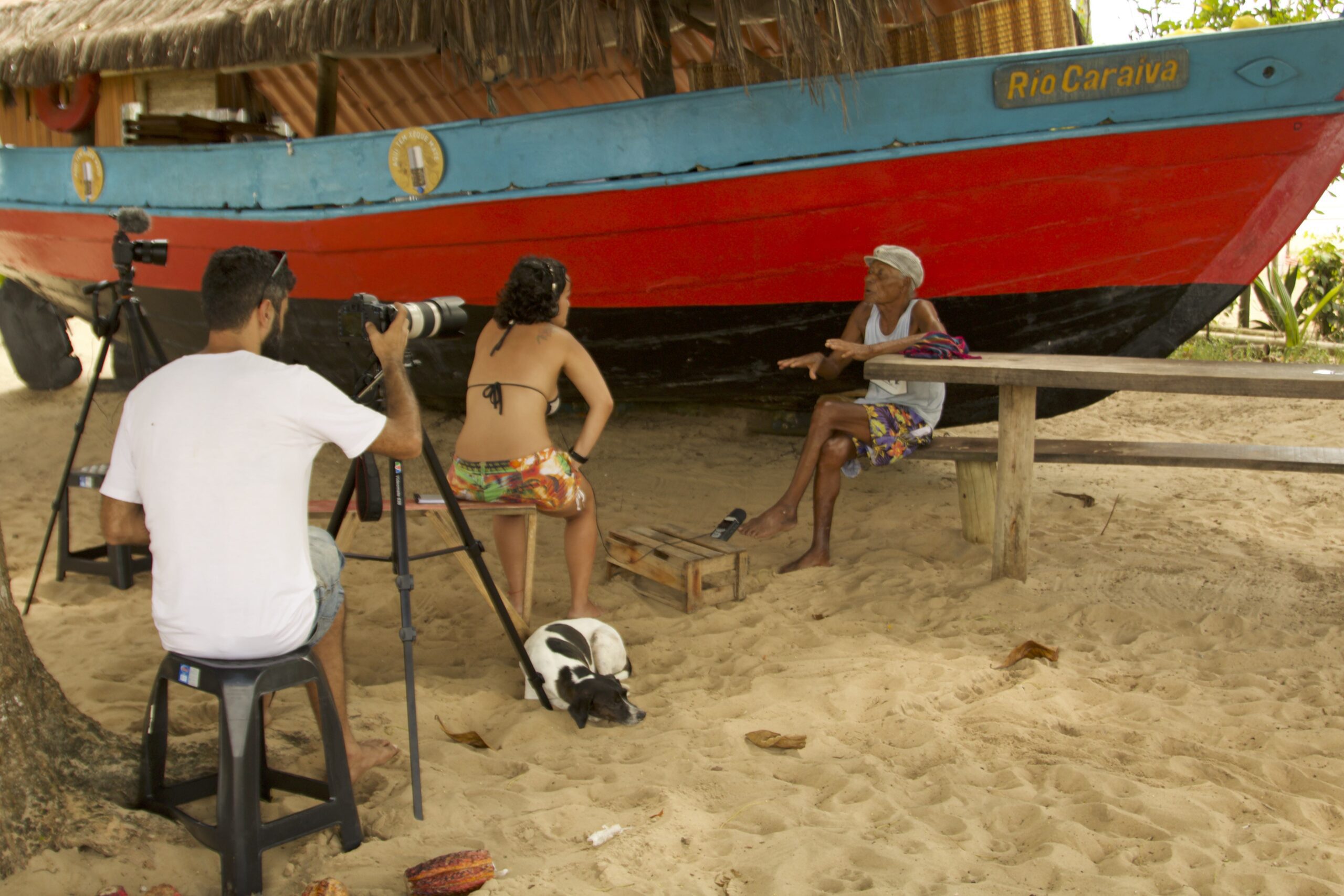Short film filmed in Bahia addresses the fisherman’s relationship with the sea
Recorded in late 2021, "Tazinho: O Homem e o Mar" aims to rescue local diversity and strengthen culture in Caraíva, on the south coast of Bahia.


Credit: disclosure
By: Gabriel Murga – Lupa do Bem / Favela em Pauta
The short film “Tazinho: O Homem e o Mar”, produced by the Saruê Cultural agency, based in the district of Caraíva, municipality of Porto Seguro (BA), is in the final stages of production and seeks support through crowdfunding.
Recorded between November 2021 and January 2022, the short film aims to consolidate an important movement, generating promotion, preservation and rescue of local diversity. The production aims to strengthen the cultural proposal of the village of Caraíva, located in the extreme south of Bahia.
Preservation of cultural and environmental identity in the oldest village in Brazil
The territory of Caraíva is within an environmental preservation area linked to ICMBio and ResEx Corumbau, bordering the Pataxó indigenous territory.

Caraíva is considered one of the oldest villages in Brazil. Its population of approximately one thousand residents is made up of indigenous people from the Pataxó ethnic group, families who migrated in the early 20th century and people who adopted this region for housing.
The audiovisual work in “Tazinho” aims to approach the relationship between the fisherman and the sea. In short film format, the film portrays the simple and profound look of a man who built his own relationship with space and time, leading the viewer to a new dynamic of understanding the environment where the production takes place.
The story of Tazinho, a story of Caraíva


Tazinho, the main character, is a native fisherman from a village in the extreme south of the State of Bahia, a place where tourism has overlapped with other existing activities. It is based on this context that the narrative was conducted, to show the contrasts between the gentrification of the village and the look of the fisherman and profound connoisseur of the movements of the sea and nature, with its pauses and contrasts.
The months of December 2021 and January 2022 were chosen because they are the period of high tourist season, precisely to faithfully present the contrast between the time of the character and the time of the place.
In August 2020, filmmaker and videomaker Fernanda Almeida made a short film with the character Duca, addressing her routine in Vila de Caraíva. In March of the following year, the eponymous audiovisual production entitled “Duca” was completed and submitted to film festivals, both inside and outside Brazil.
“Duca” is a 9-minute film selected for the Lift-Off Global Network Sessions 2021 and First-Time Filmmaker Sessions 2021, both based in England. As a result of the repercussions, came the desire and intention to make a record of the character Tazinho. The film “Duca” is available in its entirety at this link.
The film “Tazinho: o Homem e o Mar” will be available on streaming platforms, whose focus is on independent short films, such as Cardume, Curtaflix, among others. Lupa do Bem spoke with director Fernanda Almeida about these two audiovisual works that seek to value the memory and cultural identity of Vila de Caraíva.
Lupa do Bem: what is the importance of films like “Duca” and “Tazinho” for Vila de Caraíva?


Fernanda Almeida: I think the importance of these films is a matter of preserving the memory, first of all, of the important figures of the village, but also the construction of a narrative about the past. The stone that is thrown tomorrow and that falls yesterday. I believe that there is an audience in Caraíva today. Tourism is on the rise, and it will grow even more, I believe. Which is good, because financially it generates stability for everyone who lives in the village, no one is opposed to that.
However, the people who start to visit the village now, and especially after the quarantine, is an audience that had no link with Vila de Caraíva before, which comes a lot through social networks, through the media, for having “celebrities” like this. in the village. Tazinho’s film came about because there was interest, even in the sense of financial support from entrepreneurs in the village who liked it, who wanted to support other projects. Alethea Costa, producer, and I started talking about figures from the village that we would like to portray, and then the name of Tazinho came.
There was a demand from the crowd to get to know and to have this record about the historical figures.
Lupa do Bem: How can the maintenance of cultural identity help to tell and explain the different “types of Brazil” to people who do not have access to these places?
Fernanda Almeida: every time we make art; when we make video, when we make music, when we write a text, we are creating narrative and creating narrative you create identity. Caraíva is a place today that is portrayed in a unique way and simply by the life of tourism.
Caraíva has a lot of history, many characters, and a lot to do. It is very curious that I was the manager of an inn and when a tourist arrived to stay like this for two days, three days I would tell him it’s not long in Caraíva, it’s at least a week to get to know him. And people were amazed when I said that because I’m such a small village that today it must have a thousand inhabitants, which has a km from one end to the other at most.
I used to say: you’re staying for a week, there’s a lot to do, a lot to meet, a lot of people to meet and a lot of history. There are several Brazils, several Caraívas and several Brazils within Caraíva. Because Caraíva is rich in tourism, the one that is not so rich, but which also lives off tourism. There are the Pataxós who live in the villages, who circulate around the village and also make a living from tourism. The natives who are the Bahians, whether they were born there in Porto Seguro or in other regions of Bahia. As Caraíva is one of the most sought after places for tourism in Brazil, I believe that we have this role of creating and recreating identity in the Vila and even in Brazil, after all, this is the oldest village in Brazil.
Lupa do Bem: what is the importance of preserving memory or nature, which in certain cultural relationships merge, so that places like Caraíva can be kept within their cultures?
Fernanda Almeida: regarding nature, I think this is perhaps a point that has not yet been addressed in these narratives. “Tazinho” will approach this, but with a somewhat poetic look.


We want to talk about its relationship with the sea, but not so much in the didactic sense of preservation. I think that the film tends to generate a certain discomfort when watching it, because we are going to contrast a lot with the rhythm of the village during the summer. [The movie] was filmed in January, which is the busiest period and the rhythm of the sea. But the environmental issue is already a debate among residents, as is the issue of preservation in Rio, the issue of irregular constructions that are growing a lot in Caraíva, I hope we can contribute to that as well.


